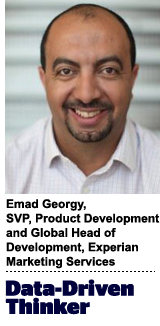 “Data-Driven Thinking” is written by members of the media community and contains fresh ideas on the digital revolution in media.
“Data-Driven Thinking” is written by members of the media community and contains fresh ideas on the digital revolution in media.
Today’s column is written by Emad Georgy, senior vice president of product development and global head of development at Experian Marketing Services.
In the age of the half-read article, far too few have taken the time to understand deeply what big data can do for their business. The focus has been more on the medium, with more talk about channels, clouds and the data than about the customers themselves.
This begs the question: What does a marketing ecosystem look like when we focus on the customer and work backward from there? It’s not about the cloud; it’s about the customer.
Looking for big answers in the channel and the technology is important, but focusing on the “how” of big data can obscure the reasons for why we use the data. It’s as if some are staring at a large explosion of data and wondering, “What can I do with this data? How can it benefit my business?” This is backward at best.
With more data in our marketing ecosystem, the complexities of mining and predicting have increased exponentially. More marketing communities are investing in data scientists as a result. But there’s something out there bigger than big data: the big questions we want answered and the answers themselves. Now we need to identify the big questions and answers that can come out of this big data boom.
One of the keys to answering the right big questions: predictive analytics. Predictive models and tools are easier and more accessible than ever, with the ability to put big data insights into an automated, future-finding realm that is becoming more open by the day. This accessibility enables professionals in every industry to answer in mere minutes questions that would have once required many years and millions of dollars.
The Right Questions
Before we identify what the right questions are, it’s important to understand what the right questions are not. Marketers often view predictive analytics as the solution to their budget optimization decisions. Sure, CMOs are under increased pressure to predict future spending and adjust channel budgeting accordingly. Real-time predictive analytics allows them to do this without waiting for end-of-the-month reporting. This is an important decision, and analytics can help.
But marketers need to go beyond the budgeting mindset to consider the customer’s role in analytics. Customers offer up so many other data points as they engage with a brand, and marketers are responsible for using that information to improve the customer’s day-to-day experience.
So what are the right questions? Here are a few.
- Who is my best customer segment? Keep in mind that this is a transient answer and can change in real time.
- Who is showing signs and/or probabilities that they are going to become my next best customer segment?
- Which cross-channel consumer experiences are resonating, and when and where?
- Which customers are showing behaviors that may predict a lack of engagement or declining engagement?
By asking the right questions, marketers can move beyond the marketing mix budget question. Predictive analytics can offer insight into what types of consumer segments are resonating in which channels, at which times of day, for which products and at which point in a path to purchase. It can give insight into things that are about to happen – when a customer is about to fit your “best customer profile,” or perhaps the warning signs to predict when a customer is about to terminate the relationship.
Real-time capabilities to understand and optimize buyer personas, to deliver contextually relevant messages to individuals, not demographics, are just some of the ways we can leverage these capabilities. Building intelligent, mutually beneficial interactions for individual customers requires knowing these signals.
Avoid The Snapshot
Predictive analytics is so important for optimizing the customer experience because a customer’s experience – whether it’s preferences, behavior or desired conversations – can change every second. Models that are used to inform the marketing experience can’t be built from static variables, but rather must learn and adjust in real time. When the insights are made predictive and are constantly attuned accordingly, a critical shift is made: Customers, not marketing technologies, are driving the intelligence.
And that’s the crux of the crossroads we face. We’ve focused for so long on the how of analytics that we’ve forgotten the human side. The algorithms and technology we’ve built are impressive and incredibly useful, but predictive analytics can’t be entirely machine-run. There’s a human element that must coexist and we must recognize that behind the data are real, irrational humans with constantly changing and sometimes unpredictable stories.
We mustn’t let our obsession with the “how” of data get in the way of the “why” we care. That is what customers want: seamless, integrated experiences that are contextually relevant to their wants and needs.
Follow Experian Marketing Services (@ExperianMkt) and AdExchanger (@adexchanger) on Twitter.












